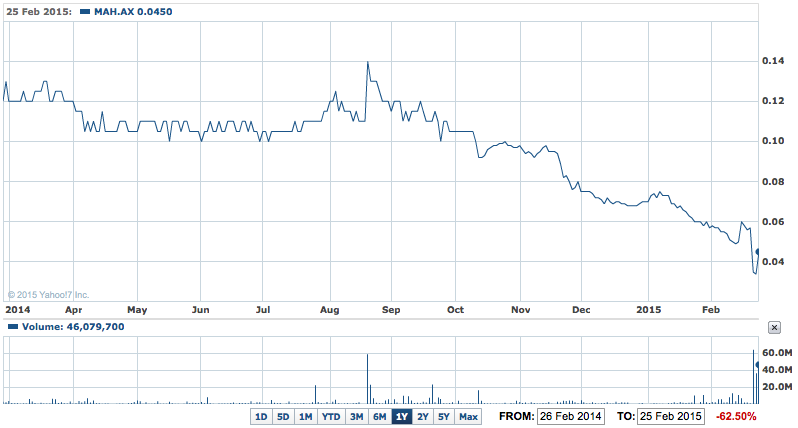And the tiddler soars … a 32% plus jump in the depressed share price of battered contract miner and civil engineer Macmahon Holdings (MAH) stood out on the ASX yesterday as the company revealed more cuts to spending and a lowered guidance for the 2014-15 financial year.
The surge – by a whole 0.9 of a cent, to 4.3 cents – came after Macmahon released its December half financials, as well as more cuts to cope with the loss of that $780 million three year contract iron ore mining job with Fortescue Metals (FMG) in WA.
That deal was axed late last week by Fortescue and given to Downer EDI (DOW), which had been the other contract miner at the Christmas Creek.
Downer got a deal worth some $650 million, and Macmahon was left to pick up the pieces and report yet another weak set of figures, only weeks after revealing plans for impairments in the December half year of up to $135 million.
Macmahon revealed an interim loss of $112.5 million, compared with the previous interim profit of $19.4 million.
And the company said it now expects full-year revenue to be between $600 million and $700 million.
Macmahon had already revised its full-year 2015 revenue forecast of $750 million to $1 billion at November’s AGM, down to between $750 million and $850 million.
The new target means revenue could up to 40% less than 2013-14’s $1 billion figure by the time the books are ruled off at the end of June.
MAH 1Y – Relief rally in Macmahon shares despite big loss

“We are looking at every opportunity to improve our productivity and reduce costs,” MacMahon executive chairman Jim Walker said in a statement to the ASX yesterday.
That’s what he told the market late last week in the wake of the Fortescue contract termination.
Macmahon reported non-cash impairments, inventory write-downs and an onerous lease of $123.8 million, and excluding these underlying after tax profit was $11.3 million.
Earnings before interest, tax, depreciation and amortisation from continuing operations fell 37.5% to $55.9 million.
As previously announced, there’s no interim dividend payment. It did not pay a dividend in the first half of the 2014 financial year.
First-half revenue fell 30% to $384.3 million from the previous corresponding period.
More red ink at June 30 when the company brings to book the impact of the loss of the Fortescue contract.
The Fortescue contract, for its Christmas Creek iron ore mine, generated revenue of $137.5 million for the December half year for McMahon.
That contract loss will see the company off to talk to its banks about its debts and finances, as the accounts explain:
"Under the terms of Macmahon’s Syndicated Facility Agreement (SFA), this results in a Review Event. During the Review Event, the Company and the SFA Lenders have 90 days to discuss the impact the reduction in revenue will have on the Company and, if required, negotiate in good faith any amendments to the current SFA terms,” the accounts state.
Macmahon had $124.7 million in cash on hand at December 31, but it also had drawn $159 million in equipment finance facility and $8.9 million of outstanding bank guarantees against its total approved syndicated (bank) debt facility of $317.5 million.
"At 31 December, the Group has net current assets of $154.8 million and net assets of $322.3 million. Included in net assets is plant and equipment of $332.0 million, of which $97.7 million is recognised at its estimated fair value (refer Note 6). The Group has initiated a restructuring review with the aim of significantly reducing the cost base of the business consistent with its reduced revenue outlook in the near term.
"The Directors have given consideration to scenarios where this Review Event leads to a repayment of drawn facility to the Group. In considering future scenarios the Directors have forecast that, by the end of the Lender’s review period (90 days), the Group will continue to require a reduced facility to allow appropriate levels of liquidity in working capital for its anticipated operations.
"The Directors are confident of the ability for the Group to continue as a going concern because in their opinion sufficient funding options are available in order to meet any potential facility repayment, including using existing cash reserves, selling assets and entering sufficient, alternative debt funding arrangements with existing or new lenders. In the event that sufficient debt facility is not agreed, then the Group may be required to pursue sales of surplus assets in a timeframe which might result in the realisation of values at amounts below their carrying values,” Macmahon directors explained.













